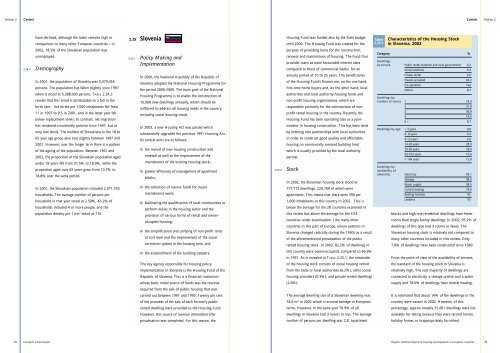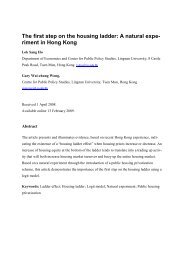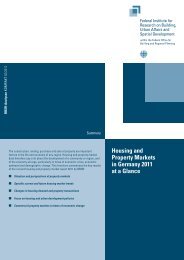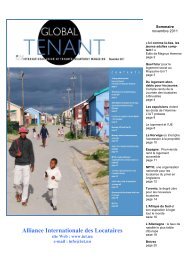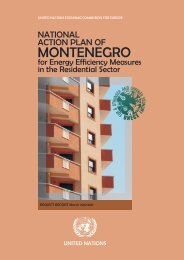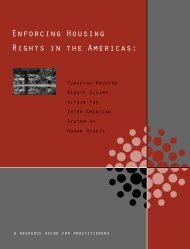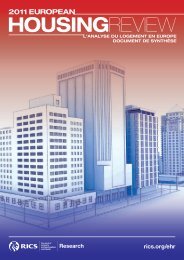housing developments in european countries - Department of ...
housing developments in european countries - Department of ...
housing developments in european countries - Department of ...
You also want an ePaper? Increase the reach of your titles
YUMPU automatically turns print PDFs into web optimized ePapers that Google loves.
Section 2<br />
Context<br />
Context Section 2<br />
have decl<strong>in</strong>ed, although the latter rema<strong>in</strong>s high <strong>in</strong><br />
comparison to many other European <strong>countries</strong> – <strong>in</strong><br />
2002, 18.5% <strong>of</strong> the Slovakian population was<br />
unemployed.<br />
2.24.4 Demography<br />
In 2001, the population <strong>of</strong> Slovakia was 5,379,455<br />
persons. The population has fallen slightly s<strong>in</strong>ce 1997<br />
when it stood at 5,388,000 persons. TABLE 2.24.3<br />
reveals that this trend is attributable to a fall <strong>in</strong> the<br />
birth rate – live births per 1,000 <strong>in</strong>habitants fell from<br />
11 <strong>in</strong> 1997 to 9.5 <strong>in</strong> 2001, and <strong>in</strong> the latter year fell<br />
below replacement levels. In contrast, net migration<br />
has rema<strong>in</strong>ed consistently positive s<strong>in</strong>ce 1997, but at<br />
very low levels. The number <strong>of</strong> Slovakians <strong>in</strong> the 18 to<br />
65 year age group also rose slightly between 1997 and<br />
2001. However, over the longer term there is a pattern<br />
<strong>of</strong> the age<strong>in</strong>g <strong>of</strong> the population. Between 1961 and<br />
2002, the proportion <strong>of</strong> the Slovakian population aged<br />
under 18 years fell from 31.5% to 18.9%, while the<br />
proportion aged over 65 years grew from 13.7% to<br />
18.8% over the same period.<br />
In 2001, the Slovakian population <strong>in</strong>cluded 2,071,743<br />
households. The average number <strong>of</strong> persons per<br />
household <strong>in</strong> that year stood at 2.59%, 43.2% <strong>of</strong><br />
households <strong>in</strong>cluded 4 or more people, and the<br />
population density per 1 km 2 stood at 110.<br />
2.25 Slovenia<br />
2.25.1 Policy Mak<strong>in</strong>g and<br />
Implementation<br />
In 2000, the National Assembly <strong>of</strong> the Republic <strong>of</strong><br />
Slovenia adopted the National Hous<strong>in</strong>g Programme for<br />
the period 2000-2009. The ma<strong>in</strong> goal <strong>of</strong> the National<br />
Hous<strong>in</strong>g Programme is to enable the construction <strong>of</strong><br />
10,000 new dwell<strong>in</strong>gs annually, which should be<br />
sufficient to address all <strong>hous<strong>in</strong>g</strong> needs <strong>in</strong> the country,<br />
<strong>in</strong>clud<strong>in</strong>g social <strong>hous<strong>in</strong>g</strong> needs.<br />
In 2003, a new Hous<strong>in</strong>g Act was passed which<br />
substantially upgraded the previous 1991 Hous<strong>in</strong>g Act.<br />
Its central aims are as follows:<br />
■ the revival <strong>of</strong> new <strong>hous<strong>in</strong>g</strong> construction and<br />
renewal as well as the improvement <strong>of</strong> the<br />
ma<strong>in</strong>tenance <strong>of</strong> the exist<strong>in</strong>g <strong>hous<strong>in</strong>g</strong> stock;<br />
■ greater efficiency <strong>of</strong> management <strong>of</strong> apartment<br />
blocks;<br />
■ the collection <strong>of</strong> reserve funds for major<br />
ma<strong>in</strong>tenance work;<br />
■ facilitat<strong>in</strong>g the qualification <strong>of</strong> local communities to<br />
perform duties <strong>in</strong> the <strong>hous<strong>in</strong>g</strong> sector and the<br />
provision <strong>of</strong> various forms <strong>of</strong> rental and owneroccupied<br />
<strong>hous<strong>in</strong>g</strong>;<br />
■ the simplification and unify<strong>in</strong>g <strong>of</strong> non-pr<strong>of</strong>it rents<br />
at cost level and the improvement <strong>of</strong> the social<br />
correction system <strong>in</strong> the <strong>hous<strong>in</strong>g</strong> area, and<br />
■ the establishment <strong>of</strong> the build<strong>in</strong>g cadastre.<br />
The key agency responsible for <strong>hous<strong>in</strong>g</strong> policy<br />
implementation <strong>in</strong> Slovenia is the Hous<strong>in</strong>g Fund <strong>of</strong> the<br />
Republic <strong>of</strong> Slovenia. This is a f<strong>in</strong>ancial <strong>in</strong>stitution<br />
whose basic <strong>in</strong>itial source <strong>of</strong> funds was the revenue<br />
acquired from the sale <strong>of</strong> public <strong>hous<strong>in</strong>g</strong> that was<br />
carried out between 1991 and 1993. Twenty per cent<br />
<strong>of</strong> the proceeds <strong>of</strong> the sale <strong>of</strong> each formerly public<br />
rented dwell<strong>in</strong>g were provided to the Hous<strong>in</strong>g Fund.<br />
However, this source <strong>of</strong> revenue dim<strong>in</strong>ished after<br />
privatisation was completed. For this reason, the<br />
Hous<strong>in</strong>g Fund was funded also by the State budget<br />
until 2000. The Hous<strong>in</strong>g Fund was created for the<br />
purpose <strong>of</strong> provid<strong>in</strong>g loans for the construction,<br />
renewal and ma<strong>in</strong>tenance <strong>of</strong> <strong>hous<strong>in</strong>g</strong>. The Fund thus<br />
provides loans at more favourable <strong>in</strong>terest rates<br />
compared to those <strong>of</strong> commercial banks, for an<br />
annuity period <strong>of</strong> 10 to 25 years. The beneficiaries<br />
<strong>of</strong> the Hous<strong>in</strong>g Fund’s f<strong>in</strong>ance are, on the one hand,<br />
first-time home buyers and, on the other hand, local<br />
authorities and local authority <strong>hous<strong>in</strong>g</strong> funds and<br />
non-pr<strong>of</strong>it <strong>hous<strong>in</strong>g</strong> organisations, which are<br />
responsible primarily for the construction <strong>of</strong> nonpr<strong>of</strong>it<br />
rental <strong>hous<strong>in</strong>g</strong> <strong>in</strong> the country. Recently, the<br />
Hous<strong>in</strong>g Fund has been operat<strong>in</strong>g also as a jo<strong>in</strong>t<strong>in</strong>vestor<br />
<strong>in</strong> <strong>hous<strong>in</strong>g</strong> construction. This has been done<br />
by enter<strong>in</strong>g <strong>in</strong>to partnerships with local authorities<br />
<strong>in</strong> order to construct good quality and affordable<br />
<strong>hous<strong>in</strong>g</strong> on communally serviced build<strong>in</strong>g land<br />
which is usually provided by the local authority<br />
partner.<br />
2.52.2 Stock<br />
In 2002, the Slovenian <strong>hous<strong>in</strong>g</strong> stock stood at<br />
777,772 dwell<strong>in</strong>gs, 220,709 <strong>of</strong> which were<br />
apartments. This means that there were 390 per<br />
1,000 <strong>in</strong>habitants <strong>in</strong> this country <strong>in</strong> 2002. This is<br />
below the average for the 28 <strong>countries</strong> exam<strong>in</strong>ed <strong>in</strong><br />
this review but above the average for the CEE<br />
<strong>countries</strong> under exam<strong>in</strong>ation. Like many other<br />
<strong>countries</strong> <strong>in</strong> this part <strong>of</strong> Europe, tenure patterns <strong>in</strong><br />
Slovenia changed radically dur<strong>in</strong>g the 1990s as a result<br />
<strong>of</strong> the aforementioned privatisation <strong>of</strong> the public<br />
rented <strong>hous<strong>in</strong>g</strong> stock. In 2002, 82.2% <strong>of</strong> dwell<strong>in</strong>gs <strong>in</strong><br />
this country were owner-occupied, compared to 66.9%<br />
<strong>in</strong> 1991. As is revealed <strong>in</strong> TABLE 2.25.1, the rema<strong>in</strong>der<br />
<strong>of</strong> the <strong>hous<strong>in</strong>g</strong> stock consists <strong>of</strong> social <strong>hous<strong>in</strong>g</strong> rented<br />
from the State or local authorities (6.2%), other social<br />
<strong>hous<strong>in</strong>g</strong> providers (0.3%), and private rented dwell<strong>in</strong>gs<br />
(2.6%).<br />
The average dwell<strong>in</strong>g size <strong>of</strong> a Slovenian dwell<strong>in</strong>g was<br />
74.6 m 2 <strong>in</strong> 2002 which is around average <strong>in</strong> European<br />
terms. However, <strong>in</strong> the same year 76.9% <strong>of</strong> all<br />
dwell<strong>in</strong>gs <strong>in</strong> Slovenia had 3 rooms or less. The average<br />
number <strong>of</strong> persons per dwell<strong>in</strong>g was 2.8. Apartment<br />
Table<br />
2.25.1<br />
Characteristics <strong>of</strong> the Hous<strong>in</strong>g Stock<br />
<strong>in</strong> Slovenia, 2002<br />
Category %<br />
Dwell<strong>in</strong>gs<br />
by tenure Public rental (national and local government) 6.2<br />
Social landlords 0.3<br />
Private rental 2.6<br />
Owner-occupied 82.2<br />
Co-operative<br />
Nav<br />
Others 8.7<br />
Dwell<strong>in</strong>gs by<br />
number <strong>of</strong> rooms 1 14.3<br />
2 31.8<br />
3 30.8<br />
4 14.5<br />
5 + 8.7<br />
Dwell<strong>in</strong>gs by age > 3 years 0.8<br />
4- 8 years 3.4<br />
9-13 years 3.6<br />
14-28 years 28.9<br />
29-58 years 39.8<br />
59-103 years 10.6<br />
< 104 years 12.8<br />
Dwell<strong>in</strong>gs by<br />
availability <strong>of</strong><br />
amenities Electricity 99.1<br />
Sewage 98.6<br />
Water supply 98.5<br />
Central heat<strong>in</strong>g 78.6<br />
Bath<strong>in</strong>g facilities 92<br />
Lavatory 93<br />
blocks and high-rise residential dwell<strong>in</strong>gs have fewer<br />
rooms than s<strong>in</strong>gle-family dwell<strong>in</strong>gs. In 2002, 95.2% <strong>of</strong><br />
dwell<strong>in</strong>gs <strong>of</strong> this type had 3 rooms or fewer. The<br />
Slovenian <strong>hous<strong>in</strong>g</strong> stock is relatively old compared to<br />
many other <strong>countries</strong> <strong>in</strong>cluded <strong>in</strong> this review. Only<br />
7.8% <strong>of</strong> dwell<strong>in</strong>gs have been constructed s<strong>in</strong>ce 1989.<br />
From the po<strong>in</strong>t <strong>of</strong> view <strong>of</strong> the availability <strong>of</strong> services,<br />
the standard <strong>of</strong> the <strong>hous<strong>in</strong>g</strong> stock <strong>in</strong> Slovenia is<br />
relatively high. The vast majority <strong>of</strong> dwell<strong>in</strong>gs are<br />
connected to electricity, a sewage system and a water<br />
supply and 78.6% <strong>of</strong> dwell<strong>in</strong>gs have central heat<strong>in</strong>g.<br />
It is estimated that about 14% <strong>of</strong> the dwell<strong>in</strong>gs <strong>in</strong> the<br />
country were vacant <strong>in</strong> 2002. However, <strong>of</strong> this<br />
percentage, approx-imately 31,681 dwell<strong>in</strong>gs were not<br />
available for lett<strong>in</strong>g because they were second homes,<br />
holiday homes or <strong>in</strong>appropriately furnished.<br />
74 European Union Report<br />
Regular National Report on Hous<strong>in</strong>g Developments <strong>in</strong> European Countries<br />
75


